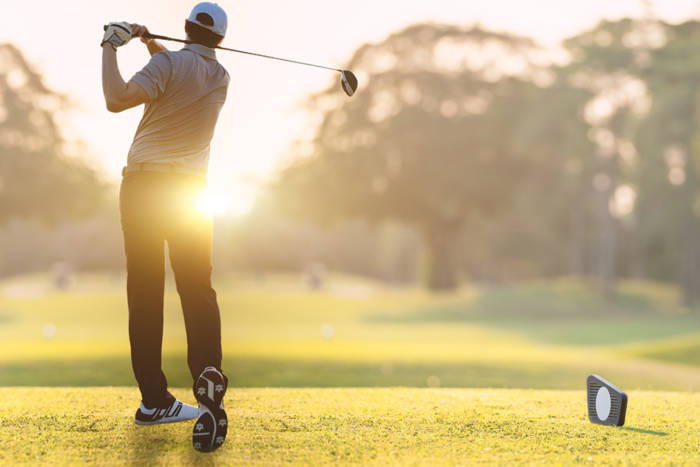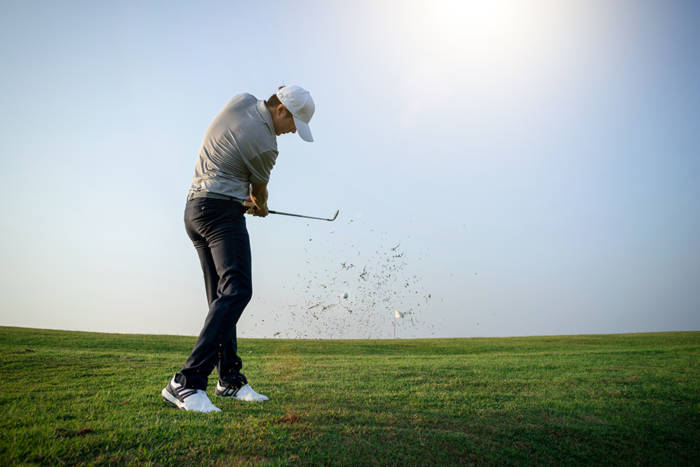What Is A Slice In Golf
While the short game is undoubtedly an essential, crucial component of any good golfer’s game, it’s undeniable that the long game is where quality golfers are truly tested.
This is because it takes an incredible amount of skill, technique, and strength in order to be able to hit a ball 150 to 300 yards and still have it land where you intended it to.
There are many things conspiring to prevent you from being able to make consistent long shots, however poor technique is the biggest issue for amateur golfers, and this is the chief cause of most inconsistency.

One of the biggest issues faced with most amateur techniques is slicing the ball, which is a specific instance where the flight of the ball doesn’t travel where the golfer intended at all (except in some cases, but we’ll touch on that later).
A slice is a shot where the golf ball curves dramatically from left to right while in flight (for right-handed golfers i.e, the majority of golfers). For left handed golfers this would be when the ball veers from right to left.
A slice is typically the nemesis for most golfers as it usually results in both reduced distance and accuracy, and is the cause of a lot of poor scores and even the occasional lost ball!
It’s a particularly common problem for inexperienced golfers (beginners or high handicappers) where the typical tendencies (or bad habits) inherited in the golf swing when starting out create the perfect conditions for a disastrous slice.
What is the difference between a fade and a slice?
You may hear some golfers refer to slices as ‘banana shots’ or ‘banana balls’ due to the extreme curvature of the ball through the air. This is key when distinguishing between and slice and a fade.
A fade shot (or cut as it’s sometimes referred to) has similar characteristics to a slice, where the ball curves from left to right in the air (for right handers) but the curve of the ball is far less extreme.
The easiest way to remember the difference is to think of a fade as a controlled curve from left to right and a slice as an uncontrolled curve.
Slices and fades can be played intentionally by experienced golfers playing at a high level, as these shots can be used to avoid obstacles and navigate difficult holes or situations. In fact, the majority of pros will hit a fade as their default shot. However, this isn’t something most players will do and is probably more of an advanced strategy.
Whilst the end result of a fade isn’t a bad shot for most golfers, the result of a slice is often a very poor shot for most golfers, unless played intentionally. There are several root causes of this issue which often comes down to one of the three reasons below.
What causes a slice?
As already mentioned, a slice is a common problem for most beginners or higher handicappers and usually comes down to one of three reasons:
Open club face – The most common and typical cause is that the clubface struck the golf ball in an open position. By this we mean that the clubface is pointing to the right of the target at impact (for right handed golfers). A square face is where the club hits the ball squarely to the target as intended. An open clubface will put cross spin on the ball resulting in a curve from left to right.
Outside to in swing – Most amateurs that struggle with a slice will naturally try and correct this by aiming further left to compensate for their slice. However, this usually results in worse shots and more extreme slices as the second most common reason for a slice is an “out to in” swing or coming across the ball. There are really only two types of shots you can hit from this type of swing; a straight pull to the left with a square clubface, or a slice with a slightly open face.
Hitting it in the heel – The final common cause of a slice is when you hit the ball on the heel of the clubface (the side closest to the shaft). Golf clubs are designed to help golfers as much as possible, and part of this is if you hit it in the heel of the club, the face and grooves are designed to impart a spin that will cause a fade or slice to bring this closer to your intended target line. Whilst it may not result in the most beautiful shot, it will probably be better than this going straight left instead!
In the case of a slice, there could be a number of reasons why you’re doing one of the above, from a poor setup to bad swing technique, bad grip, or swinging across the ball, slicing at it instead of hitting it with a full and proper swing.
In the next section we’ll take a look at these a little closer and how you can try and correct them to avoid slicing.
How to stop slicing the ball
Luckily, there are some things you can do to work on your tendency to slice the ball, bringing more consistency, accuracy, and distance to your shots and improving your game immensely.

First and foremost, you should check the following fundamentals, as these are often the reasons behind the causes of a slice and can help correct the issue quite effectively.
Check your grip
Initially you’ll want to make sure that you’re not gripping the club with an open clubface in your setup phase. A key step in how to hold a golf club correctly is ensuring you set up with your clubface square to the target. If you’re confident your clubface is square, make sure you’re gripping the club with a neutral grip. A weak grip i.e. the hands rotated too far to the left for a right handed golfer, will promote a slice as the hands work their way back to a neutral position at impact. To avoid this, set up with a neutral grip feeling the grip in the fingers of the hands.
Check your stance
Ensure you aren’t standing in an open stance. Much like how you need your clubface to be positioned squarely and strike the ball squarely, you need to stand squarely as well.
A common problem with golfers that slice is that they aim further left to allow for their slice. This actually makes things worse as it promotes a more exaggerated cut across the ball leading to more spin.
Check your ball position
The position of the golf ball in your setup can promote an “outside to in” swing or even hitting the ball out the heel if not set up correctly.
The position of the ball should change depending on the club you’re using, with the driver position being the most forward, down to the wedges being furthest back in your stance. General good practice would be to position the ball on the inside of your front lead foot for a driver or wood and in the middle of your stance for your short-mid irons.
Check you don’t have the ball too far forward in the stance as the further forward it is, the more difficult it is to swing from the inside which will prevent a slice and deliver more power.
Ensuring that all of these details are correct will often make a huge difference in preventing slices and are relatively simple things that can be learned quite easily at a driving range.
If you’re in doubt or aren’t seeing progress, you may need to seek advice from your course pro or an instructor who will be able to diagnose why you aren’t able to get your slice under control.
Can you slice the ball intentionally?
The short answer is yes, and many professional players do in the right circumstances!
If a hole is set up as a dogleg or there are obstacles in the way, a slice can be precisely the type of shot required to give a golfer an advantage on the hole as it allows the ball to avoid or travel around hazards that a standard shot may not be able to.
This is often an advanced technique, but if you can learn to stop slicing, you can also learn to reintegrate it into your game as and when required by carefully reversing the changes we discussed earlier.
Promoting an open clubface as you strike the ball by opening your stance, and hitting the ball on an outside to in swing path will all allow you to shape a shot with a slice or fade. However it’s worth practicing this on the driving range first before taking it to the course!